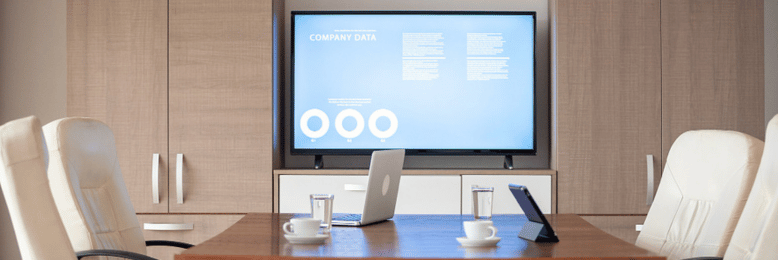How to Set Up a Wireless Conference Room (in 3 Easy Steps)
January 24th, 2024 | 4 min. read
%20-%202024-01-22T205035.828.jpg)
Creating the best office conference room environment for your staff can be a tricky balancing act - keeping functionality in the forefront while ensuring comfort for everyone in the meeting takes more planning than one might think.
Fortunately, designing your conference room wireless and toeing this line is easier than ever. You will no longer have to worry about triple-checking your cables and adaptors or the tedious cable management involved in setting up a fully functioning conference room.
With our years of experience managing the equipment of hundreds of businesses, Intelligent Technical Solutions (ITS) can help you get the exact conference room you need.
In this article, we will outline four straightforward steps to help you achieve a fully wireless conference room. We also invited Peter Swarowski, ITS Director of Operations, to weigh in on the topic and provide recommendations for your conference room.
By following the steps outlined below, you can create a seamless and efficient collaboration experience for your team, boosting productivity, and saving time and money.

Step 1: Evaluate what equipment you need.
The first step in creating a wireless conference room is defining your needs. Do you need a lot of displays? Will your meetings have remote participants and require on-site participants to work around these people?
There are several required components of a wireless conference room:
-
A Wireless Network
A stable and reliable wireless network is the backbone of any wireless conference room. It should be able to handle the number of devices in the room and provide sufficient bandwidth for smooth communication.
-
Wireless Displays
A wireless display allows participants to share their screens wirelessly, making collaborating and presenting ideas easy. The display should support high-resolution images and videos and have low latency to avoid lagging.
-
Wireless Audio Devices
A good wireless conference room should have high-quality audio to ensure clear communication. Wireless microphones and speakers can be used to capture and transmit sound without the need for cables.
-
Collaboration Tools
The room should also have tools for participants to collaborate effectively, such as a digital whiteboard, document-sharing software, and video conferencing software. These tools make sharing ideas and working together easy, even when not physically present.
Swarowski recommends evaluating all tools, even if they are not a hundred percent wireless. He points out that tools like Meeting Owl - despite having power and computer connectivity cables - are still worth looking at.
“The useful thing about [Meeting Owl] is it's kind of a standalone device that has a speaker, microphones, and a 360° camera on it", he said. “When you have an office table with people sitting around it, Meeting Owl will zero in on either the motion or the sound. So, you would adjust and put people on the screen as they are talking.”
-
Furniture and Layout
Lastly, the furniture and layout of the room should be conducive to collaboration and communication. Comfortable seating and a clear line of sight to the display and other participants help to reduce distractions and ensure everyone can participate fully.
Once you have listed your priorities and equipment, you can proceed to the next steps.

Step 2: Finalize your design for a wireless conference room.
A wireless conference room should provide a comfortable, reliable, and efficient environment for participants to communicate and collaborate.
Here are some factors to consider when finalizing your conference room setup:
-
Compatibility
Confirm that the equipment is compatible with the devices you plan to use in your conference room, such as laptops, tablets, and smartphones. Check if the equipment supports your devices' operating systems and protocols.
-
Connectivity
The equipment you choose should provide stable and reliable wireless connectivity. Evaluate the equipment's signal strength, range, and speed and ensure it can handle the number of devices using it simultaneously.
-
Audio and Video Quality
The equipment should provide high-quality audio and video output to ensure clear communication during meetings. What is the resolution, color accuracy, brightness of the display, and clarity of the sound output? Do they meet your requirements?
-
Ease of use
The equipment should be easy to set up and use. An intuitive user interface is critical, and the installation process should be straightforward.
-
Price
Consider the cost of the equipment, including any ongoing maintenance and upgrade costs, and compare it to the features and benefits it provides. Ensure the value is equivalent to the price tag and that you are not cutting corners and getting a bad deal.
After considering all these factors, conduct a meeting between your IT staff, leadership, and an interior designer to get everything exactly how you want it - without sacrificing functionality.

Step 3: Consult with your cybersecurity expert about your wireless devices.
It is highly recommended to consult with a cybersecurity expert about the security of your wireless devices.
As technology advances, so do cybercriminals' methods to access and steal sensitive information.
Hackers often target wireless devices such as laptops, smartphones, and tablets because they are connected to the internet and can contain a wealth of personal and confidential data.
The wireless conference room should have adequate security measures in place to prevent unauthorized access and ensure the safety of the data being shared. This includes strong passwords, firewalls, and encryption.
A cybersecurity expert can assess the security of your wireless devices, recommend best practices for keeping them secure, and suggest any necessary upgrades or patches to protect your devices from potential cyber threats.
Always prioritize cybersecurity to safeguard your personal and professional data and maintain the integrity of your online presence.

About to Design Your Wireless Conference Room?
You do not need to struggle with your cable management forever. It is possible to make it wireless, and it is a simple and effective way to boost team member collaboration, productivity, and efficiency in your organization.
By following the simple steps outlined in this article, you can eliminate the need for cables and adapters and create a seamless, easy-to-use technology infrastructure. As a company focused on making technology work for our clients, ITS knows the value of technology that meets and exceeds your expectations.
With a wireless conference room, your team can focus on the content of their presentations and communication rather than the technical details and troubleshooting.
If you are ready to take the plunge and invest in the right technology to create a wireless conference room, schedule a meeting with our IT experts to begin the process.
If you are looking for more information about creating a wireless conference room, check out the following resources from our Learning Center:
Kharmela Mindanao is a senior content writer for Intelligent Technical Solutions. She’s called Ella by her friends and likes yoga, literature, and mountain climbing. Her favorite book is Anxious People by Fredrik Backman. She creates art and poetry and is on a quest to find the best cheesecake.
Topics:
